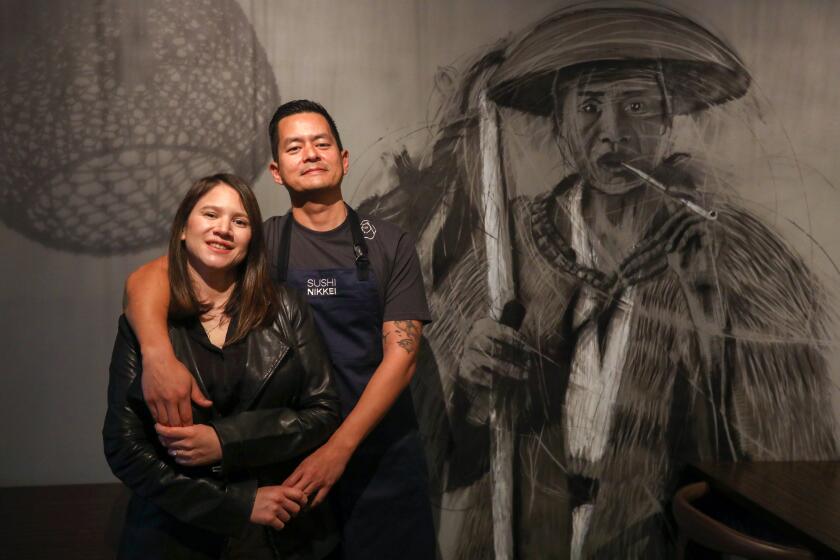Pull up a chair; it’s dinnertime
Food looms large on the cultural scene these days: We’re blessed with a seemingly endless supply of celebrity chefs, trendy restaurants, food columnists, food magazines, a Food Network and more cookbooks than you can shake a whisk at. Yet, as Gina Mallet contends in her sprightly and perceptive “Last Chance to Eat,” cooking seems to be a vanishing art. Fewer and fewer families gather ‘round the dinner table to share a home-cooked meal. For many, perhaps most, “fast food and solitary eating ... [not] just Big Macs, but high-end takeaway” have become a way of life.
Mallet, a Toronto-based writer and food critic, is clearly someone who loves good food and appreciates cooking. For her, what matters above all is taste. Recalling a simple meal at a French restaurant that stood out among many fancier yet more generic meals she’d had at higher-end establishments, she observes: “This wasn’t critics’ food; it wasn’t trying to make a splash; it wasn’t imaginative or exotic
The delights to be experienced via our taste buds, however, may be well on the way to becoming forbidden pleasures. Like Julia Child, Mallet believes we’ve managed to convince ourselves that eating is a dangerous pastime: “The first big scare was the dear little egg, an esteemed natural food for centuries. Eggs, it was alleged by food scientists, were bad for your heart. That turned out not to be true, but the scare dented the public’s confidence in food safety.” Another scare “about an inorganic chemical sprayed on apples virtually destroyed the American apple industry.” More recently, farmed salmon, so tasty, succulent and full of healthy Omega-3 fatty acids, was the victim of a similar alarm. The problem isn’t that health risks don’t exist but, as Mallet explains, that authorities and the public may have overreacted to initial findings.
Then there are the pressures from supermarket chains (even worse in Britain than here, according to Mallet) that make it harder for farmers to grow anything other than the best-looking, least perishable, least tasty fruit. Still, health concerns and the profit motive are at least understandable. More outrageous -- and utterly pointless from the perspective of health, safety or any serious consumer issue -- are some of the regulations of the European Union requiring apples to be a certain size and bananas to be straight, not curved.
In her quest to reacquaint us with the foods we once loved and took for granted, Mallet devotes a chapter apiece to the five great components of Western cuisine: the egg, cheese, beef and other meats, fruits and vegetables, fish and seafood. In each case, she approaches the subject from a variety of angles: medical, environmental, historical and personal. She’s a wonderful raconteuse: vivid, shrewd and funny. There’s never a dull moment as she segues from interviews with food scientists to recipes for chocolate mousse, cheese souffle, deviled kidneys, summer pudding and turbot bonne femme, from choice bits of culinary history to stories about her parents’ attempts to raise chickens in the postwar England of shortages and rationing. Knowledgeable she is undoubtedly. Opinionated? Yes, but when it comes to matters of food and taste, that’s almost a must, and her opinions are usually well worth considering, although she wildly overstates the delectability of raw milk. Her opening chapter on the egg is an exemplary piece of food writing. Some of the later parts, though also fascinating, seem a bit more rushed and scrappy.
Like much else in life, food is a vastly complicated subject involving a wide range of issues, from health concerns to the fate of the family farm, from animal rights to the specter of dwindling biodiversity. Most of us, alas, are inclined to prefer quick, easy answers. No red meat. No meat, period. Avoid fat. Avoid carbohydrates. Eat fish. Avoid wild fish; they’re endangered. Avoid farmed fish; they’re contaminated. Mallet provides the bewildered eater with guidance and a sense of perspective. She has done her research and is good at explaining things. When it comes to sorting out the conflicting data on health, safety and environmental issues, she is sensible and down to earth. Occasionally, she can be perhaps a little too casual, as when she blithely shrugs off the health concerns of people on chemotherapy, people with AIDS and old people (all in all a pretty sizable group): “I had a sudden vision of aged people keeling over from a taste of raw milk cheese.”
But the greatest pleasure of this book is its joyous celebration of food and cooking, which should lure at least some families back to the dinner table and some chefs back to the classic sauces and dishes that are the heart and soul of fine cuisine.
More to Read
Eat your way across L.A.
Get our weekly Tasting Notes newsletter for reviews, news and more.
You may occasionally receive promotional content from the Los Angeles Times.






